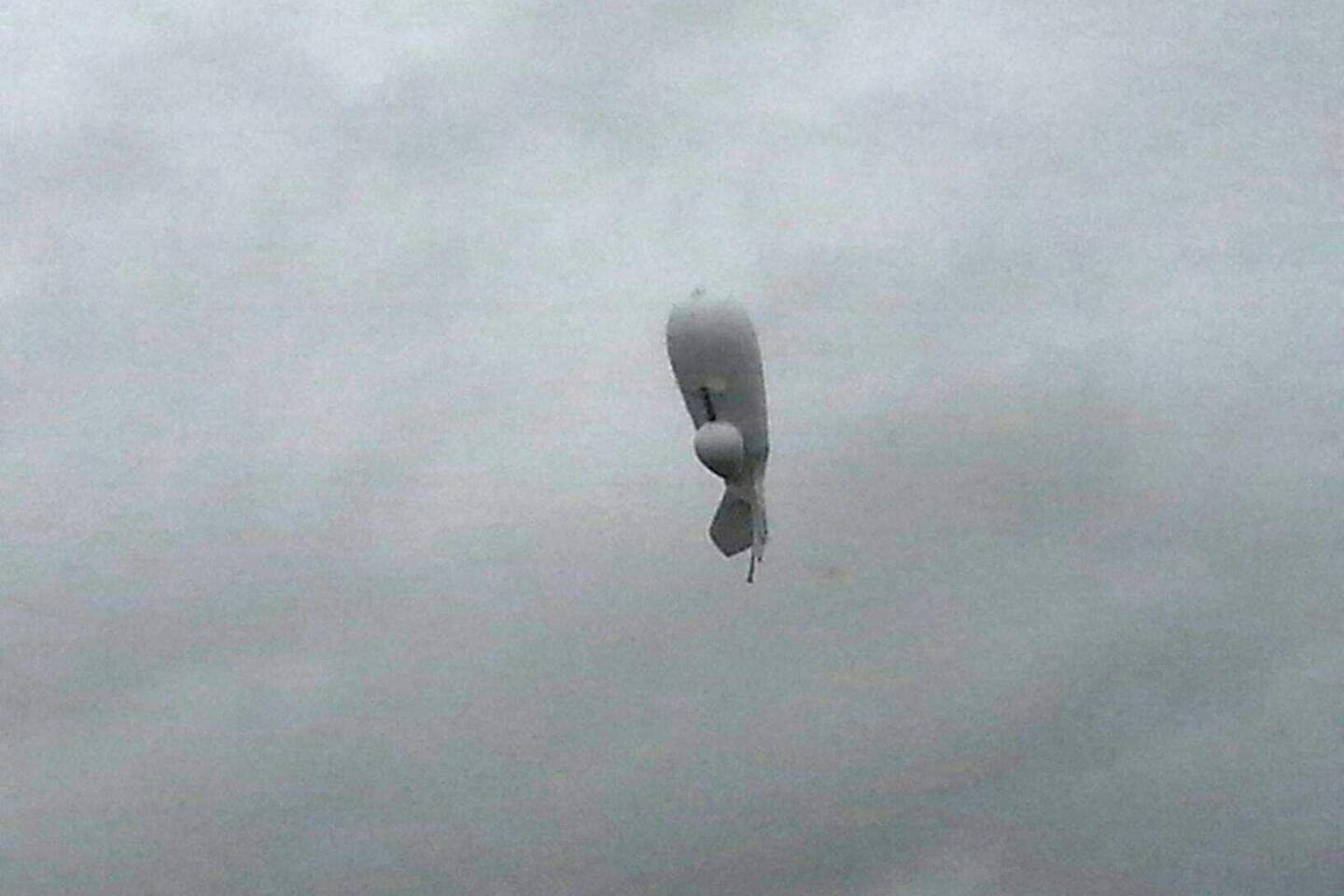After runaway blimp debacle, fresh scrutiny of JLENS missile defense program
The spectacle of a giant military blimp wreaking havoc across two mid-Atlantic states this week has prompted congressional leaders to question the worth of a long troubled missile-defense program known as JLENS.
In a letter to Defense Secretary Ashton Carter and Transportation Secretary Anthony Foxx, congressional leaders wrote that the incident Wednesday “raises questions about the value and reliability of JLENS,” a system of radar-equipped blimps designed to detect enemy missiles, drones or other low-flying threats.
The letter noted that in April, JLENS had “failed to detect” a rotary-wing aircraft that flew through Washington, D.C.’s highly restricted airspace before landing on the West Lawn of the U.S. Capitol. The craft was flown by a Florida postal worker seeking to dramatize his demands for campaign finance reform.
The letter, sent Thursday, was signed by the chairman of the House Oversight and Government Reform Committee, Rep. Jason Chaffetz, (R-Utah) and the panel’s ranking Democrat, Rep. Elijah E. Cummings of Maryland.
They asked Carter and Foxx to provide extensive records on JLENS to “help the committee understand whether JLENS is a worthwhile investment of taxpayer dollars.”
The letter requests all Defense Department contracts related to JLENS, as well as “documents referring or relating to the reliability of JLENS, including ... reliability improvement plans, developmental test results, deployment test results, electronic environmental effects testing results, and information assurance test results.”
On Wednesday, a 243-foot-long JLENS blimp broke loose from its mooring at the Army’s Aberdeen Proving Ground in Maryland and rode the winds over parts of Maryland and Pennsylvania for four hours, dragging a 6,700-foot long cable behind it.
The cable knocked down power lines and left thousands of people without electricity. Two F-16 fighter jets were scrambled to track the giant airship before it came to rest on the outskirts of Moreland Township, Pa., more than 120 miles from its base.
Since its inception in 1998, JLENS (short for Joint Land Attack Cruise Missile Defense Elevated Netted Sensor System) has cost taxpayers more than $2.7 billion -- yet it has never fulfilled its intended mission.
A Los Angeles Times investigation published last month found that in test exercises, JLENS had struggled to track flying objects and to distinguish friendly aircraft from threatening ones.
Among other problems, software glitches have hobbled its ability to communicate with the nation’s air-defense networks.
At the blimps’ maximum altitude of 10,000 feet, the radar they carry can see 340 miles in any direction, far beyond the limits that the curvature of the Earth imposes on land- or sea-based radar.
The blimps are designed to operate in pairs. One searches widely for threats. The other is supposed to focus narrowly on airborne objects and transmit “fire control” data on their location, speed and trajectory.
If JLENS were working as intended, U.S. fighter jets or ground-based rockets would use the fire-control data to intercept and destroy an intruder.
The 7,000-pound airships are anchored to the ground by high-strength, 1 1/8-inch-thick Kevlar tethers. A ground crew of about 130 is needed to operate a pair of blimps around the clock.
A 2012 report by the Pentagon’s Operational Test and Evaluation office faulted the system in four “critical performance areas” and rated its reliability as “poor.” A year later, in its most recent assessment, the agency again cited serious deficiencies and said JLENS had “low system reliability.”
Despite these problems, Raytheon Co., the prime contractor, and other backers of JLENS have marshaled support in Congress and in the military to keep taxpayer money flowing to the program.
Army leaders tried to kill JLENS in 2010, The Times reported last month. Raytheon mobilized its congressional lobbyists. Within the Pentagon, Marine Corps Gen. James E. “Hoss” Cartwright, then vice chairman of the Joint Chiefs of Staff, came to the program’s defense, arguing that it held promise for enhancing the nation’s air defenses.
At Cartwright’s urging, money was found in 2011 for a trial run of the technology — officially, an “operational exercise” — in the skies above Washington.
Cartwright retired the same year — and joined Raytheon’s board of directors five months later. As of the end of 2014, Raytheon had paid him more than $828,000 in cash and stock for serving as a director, Securities and Exchange Commission records show.
Two of the blimps have been based at Aberdeen Proving Ground to carry out the operational exercise.
Philip E. Coyle III, a former director of operational testing and evaluation for the Pentagon, said the latest setback with JLENS demands strict scrutiny of the program.
“This is yet another incident with JLENS that calls for the Congress to examine the effectiveness of the system,’’ Coyle said in an interview.
Questions surround what caused the blimp, also called an aerostat, to break loose Wednesday and drift such a long distance. A retired military officer who oversaw the program said that “a properly functioning deflation device should have brought the aerostat to a low-speed impact within a few miles” of its base in Maryland.
ALSO
Senate OKs budget and debt deal, sends measure to Obama
Video shows Iowa school bus driver assaulting student, authorities say
New Hampshire prep school grad gets year in jail for sexual assault of freshman girl
More to Read
Sign up for Essential California
The most important California stories and recommendations in your inbox every morning.
You may occasionally receive promotional content from the Los Angeles Times.












